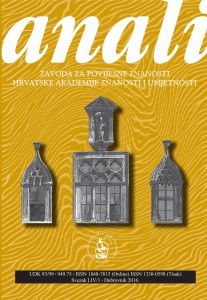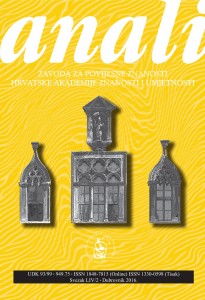
 The fifty-fourth volume of Annals of the Institute for Historical sciences of CASA in Dubrovnik has been published in two tomes, containing thirteen new studies in Croatian language. The first in this rich gallery of the portraits of Dubrovnik’s past is the text by Lovro Kunčević which analyses the reasons for the exceptional social peace and political stability of Ragusan Republic in the long period between the fourteenth and seventeenth centuries. The study by Štefica Curić Lenert and Nella Lonza represents an important overview of the history of St. Lazarus confraternity, bringing not only the list of members between 1531 and 1808, but also a detailed analysis of the internal relations which characterized this elite confraternity. A different aspect of Dubrovnik’s social history is investigated by Rina Kralj-Brassard in her study dedicated to the last urban plague epidemic of 1691, which follows not only the spread of the disease and governmental counter-measures, but also attempts to reconstruct the social networks of the victims. The same author, together with Marinko Marić, investigates the everyday life of Nikola Bošković, the father of the famous eighteenth-century Jesuit scholar Ruđer Bošković, bringing a series of new information about this immigrant from Orahov Do in Dubrovnik hinterland and his extensive family. The history of criminal court in Dubrovnik is the topic of the two following contributions in the volume. Analysing the records of the criminal court when the trespassers/culprits were the members of Valjalo-Kutlić family, Antun Koncul, Radmila Šutalo i Ivana Lazarević present the annual and seasonal distribution of crimes, their typology, and the factors which caused their reoccurrence. Ana Prohaska, Ida Gamulin i Irena Ipšić investigat the institution of collective responsibility in front of the Dubrovnik criminal court in the eighteenth century, the so-called „bližika“, stressing its function as a mechanism of social control and crime prevention.
The fifty-fourth volume of Annals of the Institute for Historical sciences of CASA in Dubrovnik has been published in two tomes, containing thirteen new studies in Croatian language. The first in this rich gallery of the portraits of Dubrovnik’s past is the text by Lovro Kunčević which analyses the reasons for the exceptional social peace and political stability of Ragusan Republic in the long period between the fourteenth and seventeenth centuries. The study by Štefica Curić Lenert and Nella Lonza represents an important overview of the history of St. Lazarus confraternity, bringing not only the list of members between 1531 and 1808, but also a detailed analysis of the internal relations which characterized this elite confraternity. A different aspect of Dubrovnik’s social history is investigated by Rina Kralj-Brassard in her study dedicated to the last urban plague epidemic of 1691, which follows not only the spread of the disease and governmental counter-measures, but also attempts to reconstruct the social networks of the victims. The same author, together with Marinko Marić, investigates the everyday life of Nikola Bošković, the father of the famous eighteenth-century Jesuit scholar Ruđer Bošković, bringing a series of new information about this immigrant from Orahov Do in Dubrovnik hinterland and his extensive family. The history of criminal court in Dubrovnik is the topic of the two following contributions in the volume. Analysing the records of the criminal court when the trespassers/culprits were the members of Valjalo-Kutlić family, Antun Koncul, Radmila Šutalo i Ivana Lazarević present the annual and seasonal distribution of crimes, their typology, and the factors which caused their reoccurrence. Ana Prohaska, Ida Gamulin i Irena Ipšić investigat the institution of collective responsibility in front of the Dubrovnik criminal court in the eighteenth century, the so-called „bližika“, stressing its function as a mechanism of social control and crime prevention.
The second tome lays a stronger accent on the topics related to the history of culture. Thus, Slavica Stojan investigates the cultural circle of Luka and Miho Sorkočević, musicians, poets and diplomats from the late eighteenth century. Vinicije B. Lupis i Sanja Žaja Vrbica are dealing with the work of the painter Gabrijel Jurkić (1886-1974) who visited Dubrovnik throughout some 40 years, producing a series of important paintings preserved in the public, ecclesiastic, and private collections in Dubrovnik and its surroundings. Relja Seferović deals with the oral culture in the ecclesiastical milieu, writing about the Jesuit Stefano Antonio Morcelli, a gifted Latin poet and orator, who distinguished himself as a teacher in Collegium Rhagusinum, but later tactfully refused the invitation of his former disciples to become the Dubrovnik’s archbishop at the dawn of the nineteenth century. Vedran Stojanović i Nella Lonza investigate the baptismal godparenthood in the eighteenth-century Dubrovnik, approaching the relationships between the children, parents and godparents as nexuses of social relations. Similar topic was researched by Ariana Violić Koprivec i Nenad Vekarić who investigate the identity of baptismal godparents of Catholics in Dubrovnik in 1870-1871, also stressing that the text was produced as a research project within the PhD programme “The History of Population” at the University of Dubrovnik.” Franko Mirošević tackles a much later period, the time of the World War Two, presenting the history of Great župa Dubrava from the capitulation of Italy until the end of 1943, and thereby continuing his previous studies on the same subject. At the end of the second tome is the interesting study of Joško Sindik and Marijana Briški, which is dedicated to the different perceptions of the symbolic meaning of water, based on the survey of 136 people from entire Croatia, who were asked about the different connotations which they attribute to water.
The traditionally rich rubric “Recensions and critiques,” with ten reviews of mostly foreign publications, is followed by the text of Mara Marić, dedicated to the memory of Mr. Bruno Šišić, an important landscape architect and the head of Dubrovnik’s Center for historical gardens and development of landscape. This section also contains the text by Lovro Kunčević, which thanks to Professor Bariša Krekić, a doyen of Ragusan historiography, for his precious donation of several hundred rare books to the library of the Institute.
The Anali are a journal whose influence is constantly growing, a journal which is becoming not only recognizable among the Croatian and foreign researchers, individuals and institutions, but even dominant when it comes to the history of Dubrovnik. The ever stronger cooperation with the University of Dubrovnik, together with the affirmation of new researchers, leads to the opening of new topics and interdisciplinary approaches used to investigate them. All these facts clearly reveal that this scholarly journal, dedicated primarily to the investigation of the past, also has a very dynamic future in front of itself.
Relja Seferović
